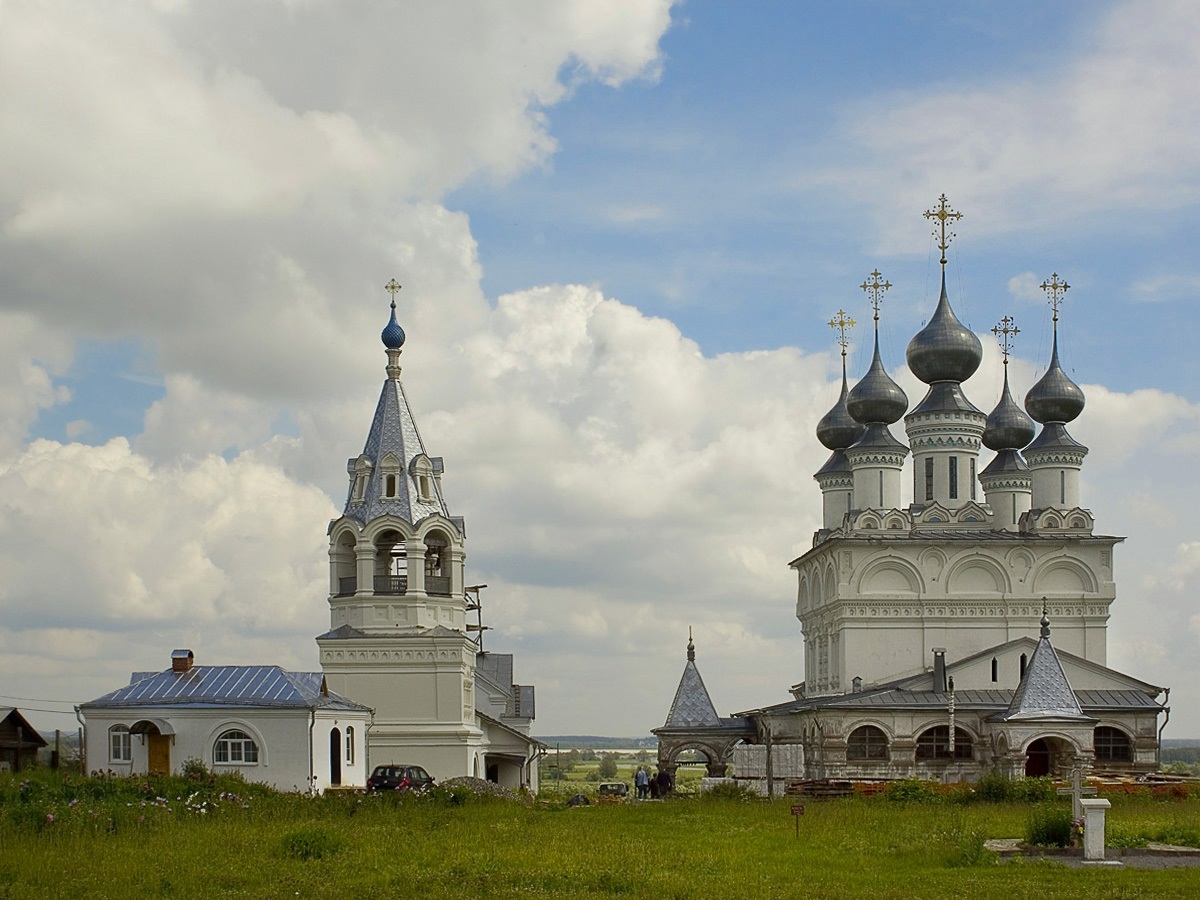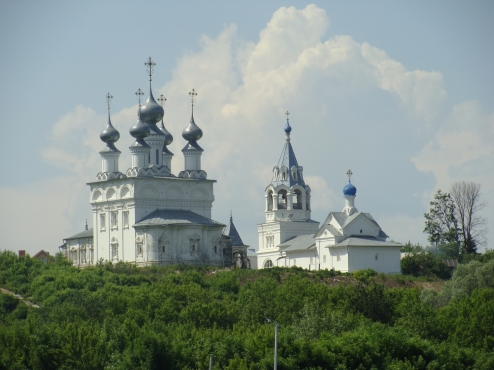Holy Resurrection Monastery
- Address:
- Murom, July lane, 1a
- GPS:
- 55.58599258, 42.05490201
- Phones:
- +7 (49234) 3-04-35
The Holy Resurrection Women's Monastery is located on the high bank of the Oka (Fruit Mountain) in the north-eastern part of the city of Murom. The history of the monastery is rather mysterious and little studied.
According to one version, it was the first female monastery of Murom, existing already at the end of the 12th century, and the only one located behind the fortified walls of the city. Travelers leaving Murom could pray in the monastery church before the long journey, and those arriving in the city – find shelter at the monastery inn. It is believed that the monastery was assigned the function of spreading Orthodoxy among the local population, who lived under the laws of matriarchy.
In one of the interpretations of the legend of the holy Murom princes Peter and Fevronia it is said that after their expulsion by the boyars from Murom in the early 13th century, they settled in the suburban princely court, in the place of which the monastery was founded. According to legend, in this female monastery Princess Fevronia at the end of her life took the veil under the name of Euphrosinia. In the monastery Fevronia-Euphrosynia embroidered with gold, which was her basic obedience. The Holy Resurrection Monastery was further famous for its embroideresses in gold throughout Russia.
In written sources for the first time the Holy Resurrection Women's Monastery is mentioned in the 16th century. One of the first reliable information about the wooden Resurrection Church refers to 1566. In the Murom inventory of 1637 mention is made of the wooden structures of the Resurrection Maiden Monastery on the mountain – the three-headed Church of the Resurrection of Christ with two chapels, the Church of the Presentation of the Virgin, the bell-tower, cells.
About 1658, at the expense of the Murom merchants Cherkasovs, on the site of wooden structures stone temples were erected – the five-domed Resurrection Cathedral with two chapels and a modest one-headed Church of the Presentation of the Virgin. The Resurrection Cathedral in its architectural forms had much in common with the previously built Trinity (Trinity Monastery) and Annunciation (the Annunciation Monastery) cathedrals. However, the Resurrection Cathedral was distinguished by its later annexation – tented porches and a bypass gallery, which performed not only a decorative role, but also allowed nuns and parishioners to admire the beautiful panorama beyond the Oka. The ensemble of the Resurrection Monastery was completed by the gate bell-tower attached to the Church of the Presentation of the Virgin (probably at the end of the 17th century). According to eyewitnesses, picturesquely situated on the steep banks of the Oka river, the Resurrection Monastery was one of the most perfect architectural ensembles of Murom.
The Holy Resurrection Convent, having a small parish, only 26 houses, in 1764 was abolished by the decree of Catherine II on secularization of church lands. The abbess and several nuns were transferred to the Trinity Monastery, and the Resurrection Cathedral and the Church of the Presentation of the Virgin became parish. To the temples adjoined one of the four ancient city cemeteries, where many of the honorable Murom townsfolk were buried. Among them – M.V. Dyakonov (1807-1886), a well-known watercolor painter, for 20 years served as director of the St. Petersburg Drawing School for free-lance, whose pupil was the outstanding Russian artist I.E. Repin.
In the 1930s, the Resurrection Parish was abolished and shared the sad fate of many of the Murom temples. The churches were closed, the bells were dropped and the wall paintings were irretrievably lost. The most valuable icons and objects of church utensils were taken to the Murom Art Museum. The buildings of the former monastery alternately occupied warehouses, a student hostel, a driving school, a children's sports school. The cemetery was destroyed and partly rolled into asphalt. In its place in 1950, a football field was set up. In the Resurrection Church there was a gym with a ring, under the bell-tower there was a sauna.
In 1998 the temples of the Resurrection Monastery returned to the Vladimir-Suzdal Diocese, and monastic life was revived in it. The convent was attributed to the Holy Trinity Monastery. In 2000, the Resurrection Women's Monastery gained independence. Its first nuns took upon themselves all the difficulties in restoring the monastery's temples and buildings, and building up a homestead farming. In connection with the formation in 2013 of an independent Murom diocese, the monastery was transferred to its jurisdiction.
Not far from the Resurrection Monastery in Stapsky ravine is the holy spring of Peter and Fevronia of Murom. Not only nuns, but also residents of Murom participated in the improvement of the spring. A wooden chapel is erected above the source, on the wall of which there is a plaque depicting the holy spouses Peter and Fevronia.
 Tourism portal of the
Tourism portal of the
